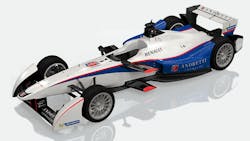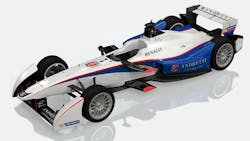Q&A: Houston Mechatronics on the Rise of Robotics and RoboBusiness 2015
With the annual RoboBusiness conference coming up fast (Sept. 23-24 in San Jose), I had a chance to talk beforehand with some of the participants. One was Matt Ondler, president of Houston Mechatronics. This is an engineering firm focused on the robotic and automation industries; notably, it is working with Andretti Motorsports to develop the electric drive train for the latter’s Formula-e car (see figure).
Wong: What do you see as the challenges ahead in the robotics and automation industry?
Ondler: I believe there are a few interesting problems and challenges. One is building machines for unstructured environments. It is one thing to build a robot that operates in an environment that is known and doesn’t change—or at least not very often—but more challenging to build a machine that can handle and adapt to ever-changing environments. For example a typical industrial welding robot operates in a very structured environment. The car chassis arrives into the work cell in the same orientation and position every time. The robot does exactly the same thing every time. It is much more difficult to build a machine to operate in an unstructured environment, something like recovering debris that has fallen off an off-shore drilling rig.
Another challenge is creating machines that can do heavy work and still be safe around humans. Your home robot vacuum cleaner isn’t going to hurt you if it bumps into you. But a robot that is carrying sheets of plywood around a construction site is powerful enough to hurt someone, so building in the sensing systems and software to make these automated heavy work machines safe is a challenge. Another is dexterity: There are many robotic jobs that required the level of dexterity of the human hand. Finally, power systems are a challenge. Getting more and more energy density will continue to be a thrust in robotics.
Wong: What is your role with RoboBusiness, and why do you think the conference is important?
Ondler: We are an exhibitor at the conference and see it as a tremendous marketing opportunity. We are looking forward to meeting potential new clients and understanding their needs and issues. We also see the conference as an opportunity to stay abreast of the latest trends and breakthroughs. Finally we are using our presence at the conference to meet and build relationships with other robotics companies. We believe in partnering with other companies where we might have complimentary skills and together offer a better solution to market.
Wong: Your company is just over a year old. How did you form?
Ondler: We had all been involved in robotics at NASA’s Johnson Space Center for many years. I ran the Software, Robotics, and Simulation Division for about five years. During that time we developed Robonaut2 and Lunar Electric Rover prototypes, among many other robots. Shortly after I left NASA, the team built the Valkyrie humanoid. HMI’s first 10 employees all came out of that team, including Nic Radford. He put Robonaut2 on the International Space Station and was the Valkyrie project manager (see" Watching Robots Giving A Hand").
We saw so many opportunities to apply what we had learned at NASA to many commercial industries and challenges. We feel we all received a multi-million dollar education in robotics—an education you just couldn’t duplicate anywhere else. We also learned how to manage extremely complex projects. So one day we decided to go for it, and we have been profitable from day one and growing steadily ever since. We managed in a short time to land some great clients.
Wong: To what industries are you applying your robotic expertise?
Ondler: We are headquartered in Houston, so oil and gas is a big client base for us. Oil and gas companies are continually pushing the boundaries of their experience and technologies, and need more automation and robotics. Also, there are a lot of hazardous operations in O&G where a robot can enable the removal of a human from very dangerous environments. We also have work in advanced manufacturing: Our specialty is machines that are intrinsically safe to work side by side with humans or machines that have a high degree of dexterity. That is a much different that most industrial robots that are caged away from humans. But there are huge opportunities that require robots that can assist a skilled human to perform a difficult task.
Finally, the third market we are in is electric vehicles. We have a partnership with Andretti Motorsports to develop their electric drive train for Formula-e. As well, we have designed the electric motor and inverter for the Artega Scalo that debuted at the Frankfurt Autoshow this month.
Wong: What is the connection between robotics and electric vehicles?
Ondler: We were always designing electric motors for our robots at NASA. We routinely needed a motor that just wasn’t available in a catalog. Over the years we developed deep expertise in electric machine design for motors and inverters, but that also included custom batteries and sophisticated battery management software. HMI owns design software based on evolutionary computing, which allows our engineers the ability to optimize electric motor design across a high-dimensional design space. Everything from material selection and stator characteristics to rotor geometry are all blended into a single, optimized design to reduce cost and enhance performance. That optimized performance is what attracted the Andretti team and Artega to engage us to design their motors for their high-performance electric cars.
About the Author
William G. Wong
Senior Content Director - Electronic Design and Microwaves & RF
I am Editor of Electronic Design focusing on embedded, software, and systems. As Senior Content Director, I also manage Microwaves & RF and I work with a great team of editors to provide engineers, programmers, developers and technical managers with interesting and useful articles and videos on a regular basis. Check out our free newsletters to see the latest content.
You can send press releases for new products for possible coverage on the website. I am also interested in receiving contributed articles for publishing on our website. Use our template and send to me along with a signed release form.
Check out my blog, AltEmbedded on Electronic Design, as well as his latest articles on this site that are listed below.
You can visit my social media via these links:
- AltEmbedded on Electronic Design
- Bill Wong on Facebook
- @AltEmbedded on Twitter
- Bill Wong on LinkedIn
I earned a Bachelor of Electrical Engineering at the Georgia Institute of Technology and a Masters in Computer Science from Rutgers University. I still do a bit of programming using everything from C and C++ to Rust and Ada/SPARK. I do a bit of PHP programming for Drupal websites. I have posted a few Drupal modules.
I still get a hand on software and electronic hardware. Some of this can be found on our Kit Close-Up video series. You can also see me on many of our TechXchange Talk videos. I am interested in a range of projects from robotics to artificial intelligence.
Matt Ondler
President
Matt Ondler is president and co-founder of Houston Mechatronics and has nearly 30 years experience in engineering, management, and leadership in both government and industry. As a business executive, he performed business development, proposal development, strategic planning, program management, lead corporate innovation initiatives, and served as the company deputy chief engineer for Stinger Ghaffarian Technologies, a $600 million-a-year engineering services company. Prior to joining SGT he served 28 years with the National Aeronautics and Space Administration at the Johnson Space Center. Ondler left NASA as the Assistant Director of Engineering responsible for all Advanced Project Development in the Engineering Directorate. He also served five years as the division chief of the Software, Robotics, and Simulation Division, the organization renowned for its leadership and innovation in robotics.



